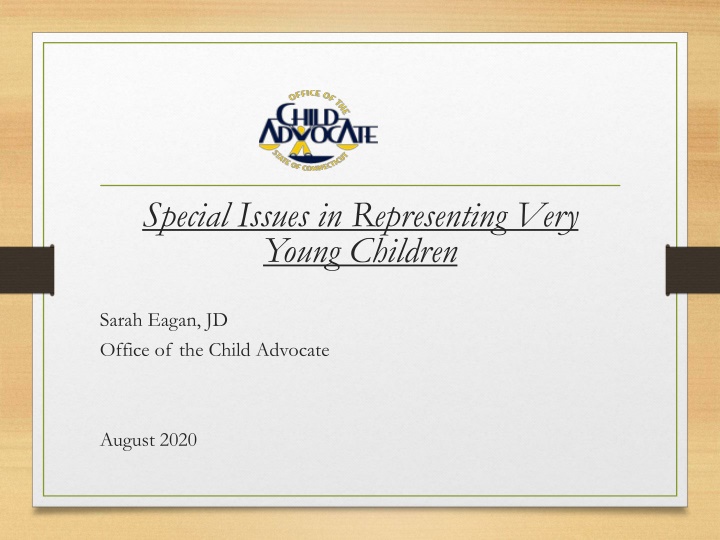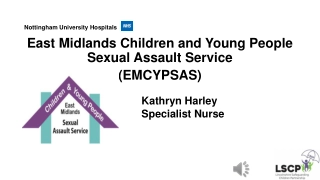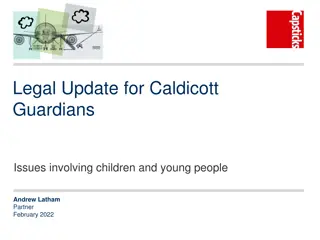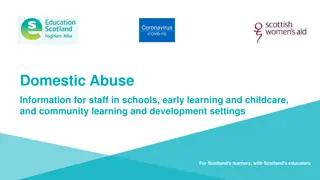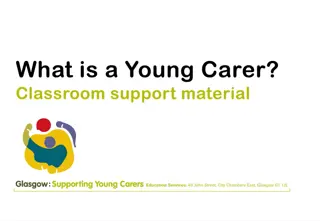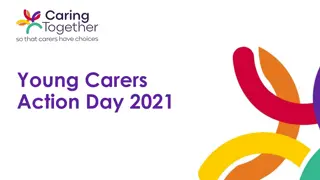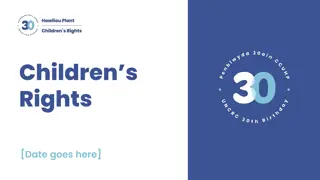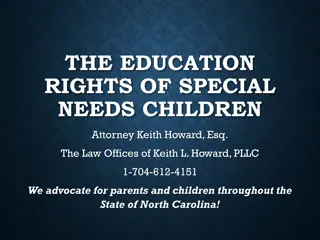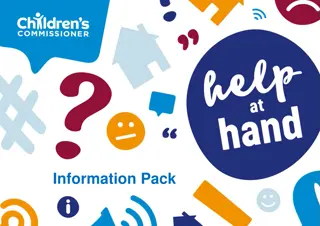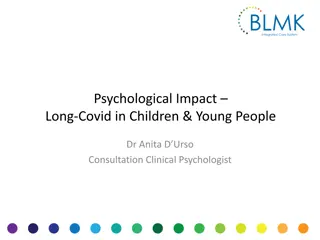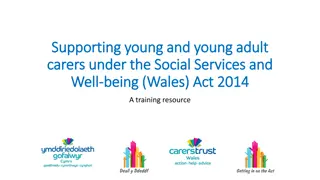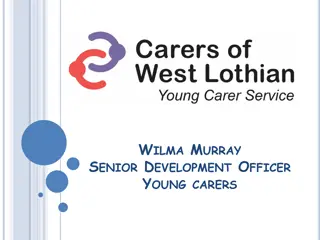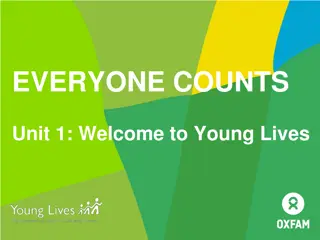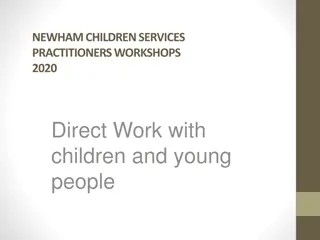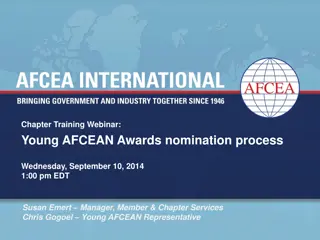Special Issues in Representing Very Young Children
This content delves into the unique challenges that arise when representing very young children, as discussed by Sarah Eagan, JD from the Office of the Child Advocate in August 2020. It highlights important considerations and strategies for effectively advocating on behalf of this vulnerable population. Eagan sheds light on the intricacies and responsibilities involved in providing legal representation to young children, offering valuable insights for professionals in the field.
Download Presentation

Please find below an Image/Link to download the presentation.
The content on the website is provided AS IS for your information and personal use only. It may not be sold, licensed, or shared on other websites without obtaining consent from the author.If you encounter any issues during the download, it is possible that the publisher has removed the file from their server.
You are allowed to download the files provided on this website for personal or commercial use, subject to the condition that they are used lawfully. All files are the property of their respective owners.
The content on the website is provided AS IS for your information and personal use only. It may not be sold, licensed, or shared on other websites without obtaining consent from the author.
E N D
Presentation Transcript
Special Issues in Representing Very Young Children Sarah Eagan, JD Office of the Child Advocate August 2020
Representing Young Children Lawyer is assigned to represent two children, a 15 month old boy and a 6 month old girl. They are removed from their parents home due to concerns about chronic physical neglect. The father and mother have a history of substance abuse (opiates), and unmet mental health treatment needs. Mother works on and off as a grocery store clerk but says she is looking to apply for disability benefits due to her mental health needs. When DCF went to check on the family, mother was alone with the two children and the social worker saw evidence of drug paraphernalia in the house along the unsanitary conditions. Mother seemed in pain and was angry that father was never around to help with the children. DCF removed the children and placed them with relatives while they sought an Order of Temporary Custody.
Oct. 2016 OCA investigative Report: Critical Injuries to Baby Dylan Removed at 13 months of age along with siblings Concerns of chronic and escalating parental neglect Placed into kinship home without other siblings Five months later Dylan was hospitalized at CCMC for injuries associated with profound neglect and abuse. He was emaciated and suffered multiple broken bones.
Baby Dylan Came into foster care with documented developmental delay. Five months later: no follow up care, scant developmental support, decreasing visits. Multiple court hearings and documents filed with the court: OTC; social study; status report; request for psychological. But no information about Baby Dylan.
Baby Dylan Records indicate that Dylan s lawyer: 1. Did not make a request for Dylan s DCF record or provider records; 2. Did not visit with Dylan in his foster home 3. Did not speak with any of Dylan s providers.
Infants and Toddlers are Highest Risk for Fatality or Critical Injury
Infants and Toddlers, High Risk Around the country approximately 80% of maltreatment fatalities are children under the age of 4. Between 2013 and 2015 (3 year period), just under 2 dozen infants and toddlers died in a manner that the medical examiner s office classified as a Homicide. More children however died from maltreatment.
Infants and Toddlers, High Risk Over a recent 5 year period in Connecticut, three times as many babies died from unsafe sleep conditions than from child abuse.
Infants and Toddlers, Unsafe Sleep Risk Factors Sleeping on a coach or chair Sleeping overnight in a car seat Sleeping in a bed with other adults or children. Sleeping with blankets, pillows, bumpers and other objects in the crib. Not sleeping on the back. Smoking occurs in the house.
Infant Death Associated with Unsafe Sleep For the most recent 5 year period studied (2011-15), there were 97 infant deaths classified as either Undetermined or Accidental, with the vast majority of fatality investigations revealing the presence of modifiable unsafe sleep factors. 2018: 21 infants died after being found in an unsafe sleep environment. No infants died sleeping on their backs in their own sleep space consistent with AAP recommendations. More than half of preventable infant deaths were children of color.
Risk Factors for Sudden Infant Death Smoking, alcohol use, or drug use during pregnancy or after birth; Bed-sharing with a parent impaired by prescribed or un-prescribed medication, alcohol, or other substances. Disproportionate number of infants who experienced sudden death in recent years were born substance exposed and/or have a parent with a documented history of substance abuse.
Young Children in the Connecticut Child Welfare System Every year, DCF serves thousands of children age birth to five.
National Picture: Young Children in Foster Care Young children stay longer in foster care. Once removed from their homes and placed in foster care, infants and toddlers are more likely to stay in foster care for more than one year than older children.
National Picture: Young Children in Foster Care Research has shown that babies and young children may be more likely to be neglected or abused while in state care, and more likely to re-enter care at a later date.
Young Children in Foster Care, High Rate of Developmental Delays National Survey of Child and Adolescent Well-Being (2012) Over 40% of three year olds involved with the child welfare system were in need of special education services due to developmental delay or an established medical condition.
Young Children: Characteristics When young children are removed from their homes due to abuse or neglect, 50% may have significant communication and cognitive delays. childwelfare.gov/pubs/partc/partc_a.cfm
Representing Young Children 1. How do I assess a child s needs when they have limited ability to communicate? 2. How can I determine developmental needs? 3. How do I protect child s physical and emotional well being?
Representing Young Children CAPTA requires that states appoint and train representatives for children in child welfare proceedings, and that such representatives have first hand knowledge of the health, well-being and safety of the represented child. 42 U.S.C. 5106a(b) (2010)
Childs Right to a Lawyer As one author writes, The CAPTA requirement reflects the view that children have interests that may differ from the interests of their parents and the state. The idea is that even though the state has brought the action to protect the child, the voice and needs of the child may get lost in the fray of the arguments and allegations between [the parties] the child needs an advocate should the state fail to deliver on necessary services and actions due to fiscal constraints and organizational failures. (Pitchal, 2006; Taylor, 2009.)
Childrens Right to a Lawyer Connecticut law requires that children in child welfare proceedings are entitled to legal representation. State court rules provide that children are legalparties to juvenile court proceedings, entitled to representation in all phases of litigation. P.B. Section 32a-1 The child or youth has the right of confrontation and cross-examination and shall be represented by counsel in each and every phase of any and all proceedings in child protection matters, including appeals.
Childs Right to a Lawyer Connecticut General Statute Section 46b-129a The primary role of any counsel for the child shall be to advocate for the child in accordance with the Rules of Professional Conduct, except that if the child is incapable of expressing the child s wishes to the child s counsel because of age or other incapacity, the counsel for the child shall advocate for the best interests of the child.
Public Defender Performance Guidelines for Lawyers Representing Children A lawyer for a child should prepare for the meeting with the child client by obtaining and reviewing relevant documents available, and consulting with the child s caregiver or DCF social worker
Public Defender Performance Guidelines for Lawyers Representing Children When the child client is non-verbal, the lawyer should conduct an initial visit with the client and should interview the child s primary caregiver, DCF social worker, and other relevant family or caregivers.
Public Defender Performance Guidelines for Lawyers Representing Children The lawyer should, at a minimum, meet or consult with older child clients at least once each quarter. For very young children, counsel should visit the child at least twice per quarter and every time the placement changes. The lawyer shall, prior to every hearing, investigate and take necessary legal action regarding the child s medical, mental health, social, education, and overall well-being.
Lawyer as Watchdog for Child: ABA Model Act Governing the Representation of Children in Abuse, Neglect and Dependency Proceedings (2011) Recognizes the right of every child to have a voice in any abuse, neglect, dependency, or termination of parental rights proceedings, regardless of developmental level. Emphasizes the lawyer s obligation to investigate and take necessary legal action regarding the child s medical, mental health, social, education, and overall well-being [to seek] court orders or [take] any other necessary steps in accordance with the child s direction [or] to ensure that the child s needs are met.
Where Do I Get Information about My Child Client? Check court petitions carefully, flag information on medical, educational, permanency needs. Ask DCF for medical information from child s provider, schedule of service, immunizations? Seek release or court order for medical and educational records. Request DCF LINK record on a scheduled basis. Discuss child s well-being with other people important to child: family members, foster parent.
Where Can I find information about my client s needs When is MDE (Multi-disciplinary evaluation?) DCF Policy 44 Child has MDE only if in foster care MDE will include developmental assessment
Where can I find information about my client s needs? MDE contains diagnoses and recommendations. Lawyers may obtain copy of MDE by written request for DCF records pursuant to Conn. Gen. Stat. 17a-28. DCF will identify child s diagnoses and treatment recommendations in child s Case Plan. Conn. Gen. Stat. 17a-15; DCF Policy 44-4-1.
Representing young children: What the Lawyer needs to know What do I know about the child s medical care and what are the child s current medical needs? Prenatal, medical home, immunizations up to date, lead screening.
What the Lawyer Needs to Know What are the conditions of the home the child is living in? Where does the infant sleep? Every time? Is the child bonded to the caregiver? Is this a safe and nurturing home? Is the child is in a permanent placement? Is the child with siblings and other people important to him or her?
What the Lawyer Needs to Know What Developmental Supports is the Child Identified as Needing and How are the Needs Being Met? Has the child been screened for developmental delays (C.G.S. 17a-106(e)) (2013). Has the child been referred for appropriate services such as Birth to Three, Home Visiting Is the child enrolled in appropriate preschool program. (P.A. 14-22).
What the Lawyer Needs to Know Does DCF have the child s medical/health care history? Does the DCF Case Plan address needs accurately and fully? Who had important relationships with child, beyond mom and dad? Does the case plan preserve those relationships? Do I need to ask the court for an order for visitation or put a visitation agreement on the record? 46b-129 (preliminary visitation orders) Does the case plan address the visitation plan. Required.
How does this work during COVID??? Ethical obligations the same. Investigate, first-hand knowledge where possible, advocate where needed. If safe in home visits ok. PPE and social distancing required. If appropriate outside visits okay. Virtual visit of home, see conditions, talk to foster parent, and see where child sleeps. DCF SW and Licensing Assessments.
Permanency Focus on visitation as linchpin to permanency. Regular visitation increases likelihood of successful reunification and reduces time in care and negative effects of separation. Smariga, Margaret. Visitation with Infants and Toddlers in Foster Care: What Judges and Attorneys Need to Know. Washington, DC: ABA Center on Children and the Law and Zero to Three National. Policy Center, July 2007, 6.
Permanency Ensure children s primary attachments are considered in placement decisions. Young children, even newborns and infants, experience long-lasting sadness, grief, loss, and rejection Separations occurring between six months and approximately three years of age are even more likely to cause later emotional harm
Childrens Legal Rights to Services Medicaid: EPSDT right to assessments, evaluations and medically necessary services. An entitlement. Adoption and Safe Families Act (ASFA) right to permanency and safety and family support. IDEA Part C (Birth to Three/Early Intervention) right to developmental supports. CAPTA(Child Abuse Prevention & Treatment Act) right to counsel and right to services. Sources of Law
EPSDT Access Federal Medicaid law requires that eligible children (including foster children) receive all medically necessary services authorized in federal statute through the Early and Periodic Screening, Diagnostic and Treatment program (EPSDT).
EPSDT Access EPSDT includes: screenings and services assessments of physical and mental health development laboratory tests (including lead blood level assessment) appropriate immunizations health education vision, dental, and hearing services
Adoption and Safe Families Act States must ensure that: families have enhanced capacity to provide for children's needs children receive appropriate services to meet educational needs children receive adequate services to meet physical and mental health needs 45 C.F.R. Part 1357 1355.34 b(1)(iii)
Child Abuse Prevention and Treatment Act (CAPTA) Child Abuse Prevention and Treatment Act (CAPTA: P.L. 108-36) was amended in 2003 to mandate states effectively refer abused and neglected children under age three to early intervention services.
IDEA Part C: Early Intervention Individuals with Disabilities Education Act (IDEA) was amended in 2004 to require that state applications for federal funds include a description of the State policies and procedures that require the referral for early intervention services under this part of a child under the age of 3 who is involved in a substantiated case of child abuse or neglect. 637(a)(6)(A)
Services Available under IDEA Part C Assistive technology devices and services Audiology Family training, counseling, home visits, parent support groups Medical services only for diagnostic or evaluation purposes Nursing services Nutrition services Occupational therapy
Services Available under IDEA Part C Physical therapy Psychological services Service coordination Social Work services Special instruction Speech-language pathology Vision services Health services Transportation and related costs
Assessment of Childs Needs Connecticut Statute 17a-101 DCF has obligation to provide child or youth with all necessary care even without consent of child s parent or guardian (provided DCF made reasonable attempts to obtain consent.)
TIPS Know How to Access Records 1. LINK record 2. Investigation Protocol (all collateral contacts made during DCF investigation time frame) 3. For OTC/committed child, specifically ask for MDE recommendations 4. Release or court order to request educational, service or medical records, speak to provider
TIPS Public Act 17-92. Amends 17a-101g. b) [The investigation] The Commissioner of Children and Families shall establish protocols for the investigation of and response to reports of child abuse or neglect of children from birth to three years of age. Such protocols shall include, but need not be limited to, (1) appropriate supervision of the case, (2) appropriate visitation by department personnel to such children, (3) documentation of case activities relevant to the safety and well-being of such children, and (4) a case supervision tool specific to the unique needs and risk status of children from birth to three years of age.
TIPS CHECK THE DCF COURT FILINGS FOR COMPLETION: Sec. 3. Section 46b-129 of the general statutes is amended by adding subsection (t) as follows (Effective July 1, 2017): (NEW) (t) If a child or youth is placed into out-of-home care by the Commissioner of Children and Families pursuant to this section, the commissioner shall include in any report the commissioner submits to the court information regarding (1) the safety and suitability of such child or youth's placement, taking into account the requirements set forth in section 17a-114; (2) such child or youth's medical, dental, developmental, educational and treatment needs; and (3) a timeline for ensuring that such needs are met. Such information shall also be submitted to the court (A) not later than ninety days after such child or youth is placed into out-of-home care; (B) if such child or youth's out-of-home placement changes; and (C) if the commissioner files a permanency plan on behalf of such child or youth. The court shall consider such information in making decisions regarding such child or youth's well-being.
TIPS Available Services for Parent/Child ADVOCATE FOR SERVICES THAT BUILD FAMILY CAPACITY Family Based Recovery intensive home-based substance abuse treatment Child First intensive parent-child clinical support. Home visiting supporting parent-child intervention, non- clinical. Birth to Three (parent strengthening model) supporting parent-child developmental intervention.
TIPS FOR LAWYERS Advocate for Basic Need Supports for Child s Family Housing Support- rent relief, supportive housing applications, security deposits. Food Insecurity support. Diapers and Formula support. Is there a community agency that can help the family longer term?
TIPS FOR LAWYERS Address visitation immediately. CGS 46b-129 permits court to issue visitation orders at preliminary OTC hearing Visitation plans must provide for parent and sibling visitation consistent with child s needs Visitation Plan must be written into case plan!
